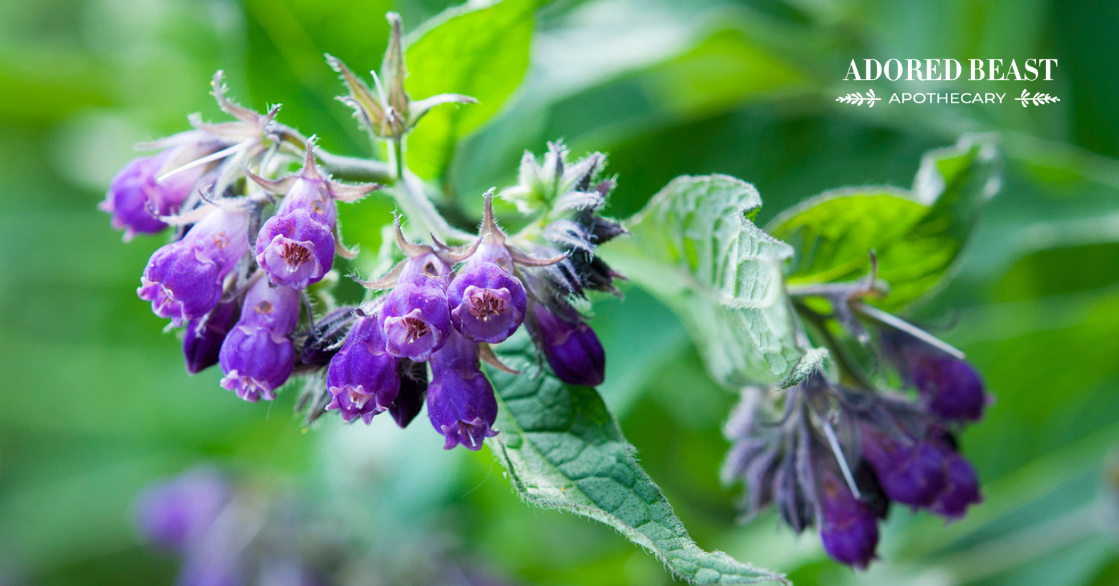If you’re at all familiar about Adored Beast, you know that homeopathy is a big part of what we do. As a trained animal and human homeopath, ABA Founder Julie Anne Lee uses homeopathy every day for herself and her many rescue animals on the farm.
And one remedy that she is sure to never be without is symphytum.
But what is homeopathic symphytum for cats and dogs? When should you reach for it – and how do you use it?
What is Homeopathic Symphytum?
The common name for symphytum is comfrey. Comfrey is a perennial shrub with yellow or purple flowers found in Europe, Asia, and North America. Various medicinal uses for comfrey date back 2,400 years.
As an herb, there are some cautions. We now know that the pyrrolizidine alkaloids in comfrey can be toxic to the liver when eaten by people and other animals. It’s really intended for short-term use. And it can have its place, if you want to explore it, we suggest working with a feline or canine herbalist.
But with homeopathy that’s not an issue – the comfrey is diluted so well that only a teeny, tiny amount of the plant is left in the final substance. In fact, it is more the plant’s energy that remains, rather than the plant itself! So there’s no need to worry about using it for yourself or your animal! It is absolutely safe.
[RELATED] New to homeopathy? Read this next to get the basis!
Benefits of Knitbone/Boneset
What can you use symphytum for dogs and cats for?
With nicknames like knitbone and boneset, you can probably guess what homeopathic symphytum is most often indicated for… Injuries to bones, cartilage, tendons, and periosteum (the outer connective tissue that covers the bone).
Symphytum helps stimulate callus formation and improves the reunion of bone. It is the key remedy for fractures and other injuries to bones.
In addition, it is often indicated for eye issues, ulcers in particular.
Research even suggests it can be helpful for pain and swelling – two things that are common with bone or joint injuries!
How to Use Symphytum for Dogs and Cats
You can find homeopathic symphytum for dogs and cats (it’s the same as for humans) online, or your local health food store will also likely have it. It comes in a variety of potencies. If you are new to homeopathy, go with a 30C potency and look for it in pellet form.
First things first – and this is important – homeopathy is not like a drug. The amount given isn’t based on weight, and it doesn’t matter if your animal has 2 pellets or 6. Again, hard to wrap your head around this one, but it’s just the way it works. As long as some of the remedy gets into your pet, the energy of the remedy will be able to get to work.
If your animal will take the pellets without issue by mouth, that’s an easy way to do it. They even have this perfect little pocket just inside their cheek that you can pop the remedy into. For cats, or pickier dogs, this might not be the easiest option. In this case, stir a few pellets into a small cup of water and give the water to your animal. That works too.
**Whenever you give a remedy, try not to touch the pellet with your fingers, and try not to touch the container to your pet’s mouth. If the container comes in contact with your animal’s mouth, wash it with hot, soapy water and make sure it dries completely.
Give the remedy and watch for any signs of improvement. If, after 30 minutes or so, you haven’t noticed a change, give it again. If, after that, you’re still not seeing a change, perhaps try a different remedy.
You can also use a combination remedy like our Jump for JOYnts. It features homeopathic symphytum along with calendula, ruta grav, and arnica. We love it because it supports healthy joints, ligaments, tendons, and muscles, as well as issues such as ACL injuries, arthritis, and bone and muscle injuries.
Whether your pet suffers from ongoing arthritis or has just suffered a recent sprain or strain, reach for homeopathic symphytum for dogs and cats – and yourself! It’s a safe and gentle – yet highly effective – option for relief.












